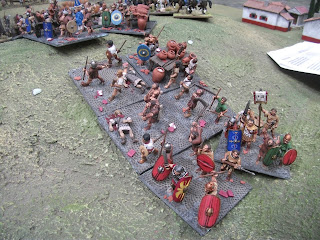These are a few pictures of the Phalanx units that Simon has created. Hundreds of figures. In ancient texts they often refer to troops "without number" and this is clearly true for Simon's collection.
I was playing the part of Antiochus Megas on leading the Seleucid army. Here you can see some Greek mercenaries supporting Elephants on the right of the Seleucid army.
One of the Phalanx units to the left of the mercenaries. 48 figures. These are led by Byttacus the Macedonian who can be seen in the left of the picture
Over on the left of the Seleucid army are units of arabs led by Aspasianus the Mede
Next to them were Medians armed with spears
Meanwhile the elephant units begin to attack. These are escorted by light troops
The Agema of Antichus hope that charges on the right of the army will cause the Ptolemaic forces to collapse.
A general view of the battle giving some idea of its scale. As usual with games at the WHC it is often likely that generals have no idea what is going on in other parts of the game.
A view of the Phalanx units of both sides closing on each other
The clash between the elephants on the right flank
Andromachus the Aspendian urges his Phalanx on
More Greek mercenaries
Troops packed into the phalanx
Superb painting on these Greeks
One phalangite clearly wants Leicester City to win the cup!
Simon's rules make use of coins to keep a running score of the moral of the two armies. When you lose all your coins then you have lost the game.
Wedges of Agema pushing through on the Seleucid right
Looking through the sea of pikes
Another view of the phalanx in the Seleucid centre
Even the back row look determined
I like to look at all the small variations that Simon's figures display
Elephants continue their advance
A view along the line of the Seleucid phalanx
Elephants closing on the enemy with the Ptolemaic phalanx in the distance
Cards turning fast in the game.
Phalanx units closing on each other
The deep pike units clash
Elephants and Agema units charge each other on both sides. Antiochus with fight it out with PtolemyThis Elephant unit looks as if it was based on the old WRG book on the Macedonian and Punic Wars
Head on collision. It should be noted that their is a difference between the Indian and African Elephants and their ability to absorb punishment the fighting
Thus picture shows that the Ptolemaic side has a problem. The phalanx unit in the top of the picture belongs to the Seleucids
The battle ended with the defeat of Ptolemy. The phalanx units in the centre broke through the opponents and began to roll up the units to the left and right. The Elephants defeated their Ptolemaic counterparts and the Agema units went on the victory despite Antiochus being killed in the fighting (loss of six coins alone for that!). Ptolemy himself was also wounded. I confess that some of the pictures were from some of the other games but they do illustrate the general progress of the game. This was the second run of the game in which Antiochus was killed which gave rise to a series of Zombie related novels the first entitled "What Antiochus is dead again?" Simon and a second "Well Antiochus is still dead" Matthew. A very good game and an excellent weekend. Well don Simon and Mark





















































